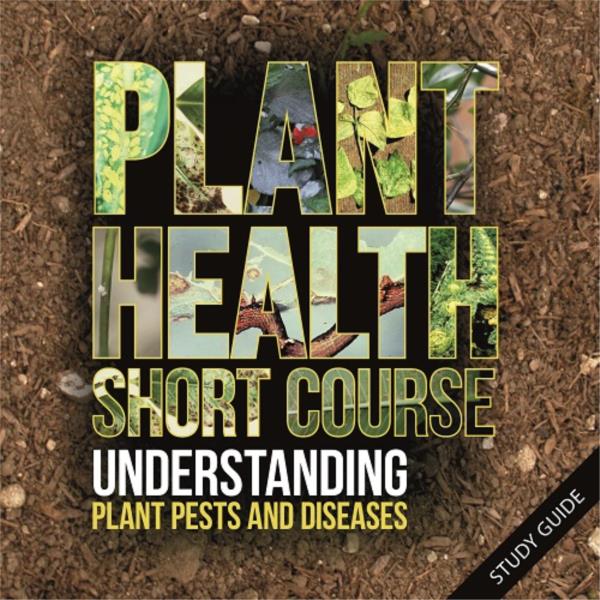Home > Short Courses
Plant Health Short Course
Sneak Peek
Plant Health Short Course - Understanding Plant Pests And Diseases
It always seems that the more work you do in a garden, the more pest and disease problems seem to appear. For this reason, the keen home gardener and the professional landscaper need to be aware about what pests and diseases they may come in contact with, and how to control them.
This Study Guide will help in the identification of these problems. Without correct identification, it would be very difficult to suggest a suitable method of control. For example, a hole in a leaf may indicate damage by a pathogen such as a fungus, bacterium, or virus, or it could be caused by an insect. If you thought the problem was caused by an insect and sprayed it with an insecticide, but it was actually caused by a virus, then the spray is totally wasted.
This Study Guide will help the home gardener and those working in horticulture at an entry level to identify and control a range of the most common pests and diseases of plants.
We live in an age of heightened environmental awareness where there is an emphasis on caring for our environment through sustainable land management, farming, and horticultural practices which includes reducing the use of chemicals. It is therefore important that plant problems are correctly identified so that an appropriate treatment can be chosen. This will help to prevent useless spraying of possibly harmful chemicals or, perhaps more importantly, the spraying of beneficial insects.

This course covers 6 lessons:
Lesson 1: Identifying problems
- Understanding what can go wrong with your plants
- More than one problem
- Finding out what the problem is
- Conducting an inspection
- Alternative approach
- Still unsure?
- Telltale symptoms
- The main types of problems
- Pests
- Diseases
- Shortcuts to problem identification
- What insect is it?
- Diagnosis of plant disorders
- Difficult to diagnose problems
Lesson 2: Treating problems
- Different ways to control pests and diseases
- 1) Cultural control
- 2) Biological control
- 3) Physical controls
- 4) Chemical
- 5) Legal control
Lesson 3: Problems and the plants they affect
- Flowers & bulbs
- Fruit & vegetables
- Indoor, shade & greenhouse plants
- Shrubs & climbers
- Trees
- Lawns
- Australian natives
Lesson 4: Pests
- The major types of pests
- Common garden pests
- Millipedes
- Wasps
Lesson 5: Diseases
- Disease considerations
- Types of pathogens
- Symptoms
- Understanding diseases
- Stages in the development of a disease
- Common diseases
Lesson 6: Environmental problems
- Common environmental problems
- Foliage burn
- Pollution
- Lack of water
- Drainage problems
- Frost
- Hail
- Shade
- Temperature
- Wind
- Plant tolerance levels
- Ways to protect plants
- Protective structures
- Staking
- Tree guards
- Wind breaks
- Mulching
- Environmental problems in lawns
- Appendices
- Spray programmes
- Stages of growth
- Simple conversions
- Further information
- Publications/bibliography
- Diagnosis services
- Glossary
Identifying Plant Diseases and the Correct Treatment
Quick methods for assessing plant problems tend to be less technical
and include things like: matching the problem to a photograph or
description (in a book or on a chart), checking problems common on that
plant, and identifying broad groups rather than specific diseases.
Before applying the best treatment, one needs to know what is causing
the problem/s. It requires a great deal of knowledge and expertise to
be able to precisely diagnose plant troubles. Do not expect to develop
such ability quickly. The first and perhaps most important skill to
develop is how to inspect a plant in order to discover the telltale
symptoms which will provide an indication of what is wrong. This process
requires practice and careful observation. You will learn the
techniques and what is used to treat a variety of diseases.
Features:
- Enrol any time of day or night.
- Start studying immediately or later (as you wish).
- Configure your study sessions at any length and frequency you wish.
- Work through at your own pace.
- Help desk- contact our help desk here with the subject title: 'Help Desk Short Course' .
- Automated self assessment tests pop up at the end of each lesson. You can attempt these as many times as you wish; and each time, upon completion, you can see your results.
- At the end of the whole course, you are presented with a major automated examination which can be attempted online, anywhere, anytime.
- If you achieve a 60% pass in the exam; you immediately receive a downloadable certificate of completion with your name on it.
Example Pages from the Study Guide


Write a Review
Please ensure you are logged in to write a review.
Plant Health Short Course

£120.00
In stock